John Grigg
Senior Lecturer
Save Sight Institute, University of Sydney
Sydney Eye Hospital & Children's Hospital at Westmead
[email protected]
Definition
A measure of the resolving power of the eye and refers to the spatial limit of visual discrimination
- Diffraction
- limitation of aperture causes a spread of light even in a fully focused system - Aberrations
- peripheral rays may not converge on geometric image point
- contributing to spread of light beyond that caused by diffraction - Scatter
- due to microscopic structures in the ocular media - Absorption
- shorter wavelengths the greater the absorption - Focus factors
- accommodation stance may not always match stimulus distance - Retinal Anatomy
- diameter of retinal receptors a physical limitation to partitioning spatial information
- Minimum visible
- Minimum resolvable
- Minimum discriminable
- Stereo acuity
- The minimum visible is a light discrimination function
- It includes brightness sensitivity and brightness discrimination
- Minimum visible acuity is the ability to detect a small difference in the brightness of two light sources
- It determines the presence or absence of a target against a background
- The physiologic term is local brightness difference threshold (Dl)
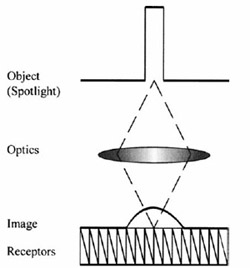
Practical Example
- Measures the minimum width of a telephone wire that can be seen against a uniformly coloured sky
- Although object changes in a spatial dimension, detection is purely a brightness change
- Threshold value is of the order of 1 second of arc
- Represents a very small fraction of the diameter of a retinal photoreceptor
- Visual acuity as measured clinically also called:
- minimum resolvable or minimum separable
- Measure of the resolving power of the eye
- A spatial discrimination function representing the smallest visual angle at which two
separate objects can be discriminated
- Resolution limit is called the minimum angle of resolution (MAR)
- Normal minimum angle of resolution 30sec to 1 min of arc
- Clinically, use such systems to assess visual acuity
- spatial judgment eg P or F, B or R, C or O
- examples of minimum resolvable include the Landolt C and Snellen E - Concordance between minimum angle of resolution and resolving capacity of eye's optics
- Elements for detecting doubleness
- underlying retinal image pattern with two peaks by a trough
- retinal illuminance difference between peaks and troughs that is within the ΔI adaptation
- separate localisations of the differentially stimulated region
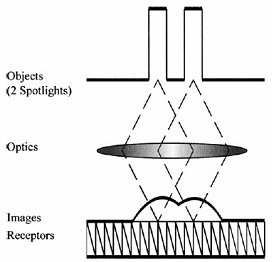
- Minimum discriminable (hyperacuity, Vernier acuity) is another example of spatial discrimination
- Determines the relative location of two or more visible features with respect to each other
- Eye is capable of subtle discrimination in spatial localization
- Detect misalignment of two line segments in a frontal plane if these segments are separated by
as little as 3 to 5 seconds of arc
- Considerably less than the diameter of a single foveal cone
- Mechanism subserving hyperacuity is still being explored
- Depends on integration of information by the visual cortex
- Vernier acuity is defined by the ability to detect small changes in alignment or position
- Vernier acuity matures extremely rapidly
- over the first 6 postnatal months
- followed by a slower rate of improvement that lasts many years
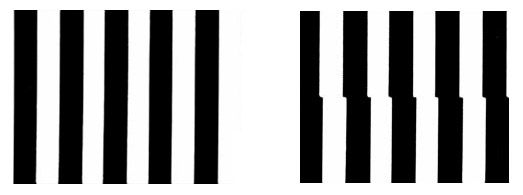
- Types of misalignment detected by this function. (A and B)
- The more conventionally used minimum resolvable distance between two objects (C)
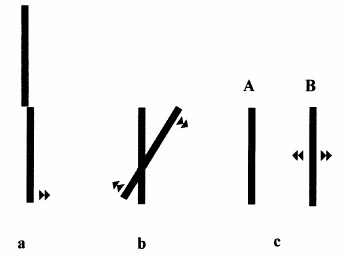
- Form of binocular function critical for depth perception
- Stereopsis is based on binocular disparity
- that is, the principle that an image is observed at slightly different angles by the two eyes
- depends on comparison of information from the two eyes within the visual cortex - Stereoacuity is a measure of the minimum detectable binocular disparity
- generally measured with pairs of stimuli consisting of patterns of randomly distributed dots
- so that binocular disparity is the only cue available for judging depth
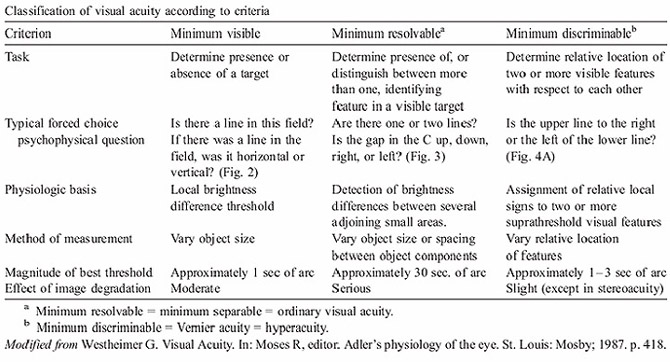
- Refractive error
- defocused optical system
- point spread function widens
- two points need to be further apart to detect
- pupil : depth of focus increase with reduction in size - Retinal eccentricity
- centre of fovea site maximum acuity
- one degree from centre 60% of maximal acuity
- due to neural connectivity with increased summation areas rather than optical blur or receptor spacing - Luminance
- visual acuity remains constant over a wide range of photopic luminances
- very high luminances > unexplained decrease in VA - Pupil Size
- VA remains constant in range 2.5 - 6.0mm
- beyond range aberrations begin to widen the point spread function
- < 2.5mm (pupil) point spread function becomes progressively wider - Exposure duration
- ↓ VA with ↓ exposure when in millisecond region
- even when ↓ luminance is taken into account - Target and Eye movement
- ↓ VA during saccades
- significant movement of the retinal image
- small movements do not ↓ VA - Meridional variations in acuity
- can be difference in VA
- difference rarely exceeds 15% - Interaction affects
- ↓ VA when targets too close together
- Max ↓ VA at 2-5 mins of arc separation
- not purely optical - Developmental aspects
- several months after birth for development of pursuit
- Aging
- acuity ↓ with age